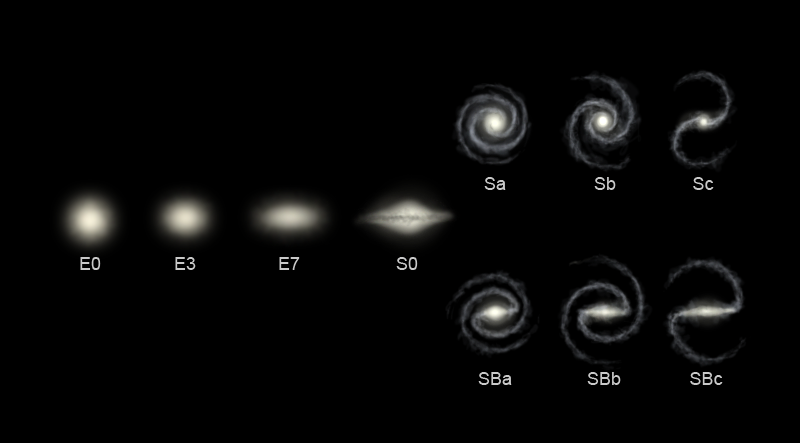Sorting out Some of those Fuzzy Things
Back when people started studying the sky with telescopes, it didn’t take long for them to run across fuzzy-looking things out there. Charles Messier, an 18th-century French astronomer took to the skies each night for many years, searching out comets (which are fuzzy-looking things). Along the way he found other things that didn’t quite resolve into starlike points of light. His list of “fuzzy things in the sky” is the root of a deep-sky list that began with the so-called “M” (Messier) objects, but is extended out to the New General Catalog (NGC, created in the 1880s) and other surveys. Not everything those surveys contain are nebulae. Some are clusters of stars (which can look fuzzy, especially through an not-quite-powerful-enough telescope), and some are galaxies.
Galaxies beyond the Milky Way (our home galaxy) were (at first) just classified as “nebulae.” They were difficult to resolve through low-power telescopes (just as they are today), but as telescopes improved, so did the view. Eventually, galaxies got separated out from things like the Orion Nebula (M42 in Messier’s list) and astronomers started sorting these “nebulae” by their shapes. The Large and Small Magellanic clouds were the first to be observed from Earth, and they were called what they looked like: clouds. After the telescope was invented and put to use by Galileo in the 1600s, later astronomers (like Messier) found these nebulae to devolve into two forms: elliptical and spiral.
As astronomers got better and better telescopes, they started seeing different “forms” of elliptical and spiral. In fact, it pretty quickly became clear that while no two galaxies were exactly alike, there were some characteristics that could be used to sort them into useful bins for study. A lot of work (and argument) got done by Edwin Hubble, who formulated the sequence we use today to classify galaxies by their shapes.
 This is the basic Hubble Sequence for galaxy shapes (often called “galaxy morphology” in the astronomy community).
This is the basic Hubble Sequence for galaxy shapes (often called “galaxy morphology” in the astronomy community).
You can pretty clearly see how different the shapes are. As with stars, you can think of the classification types of galaxies as shorthand for a longer story about how each one formed and evolved over time. There’s also a side story for each type about the families of stars that inhabit them, and there’s an evolving story that is yet to be unraveled about the influence of dark matter on these galaxy shapes. Galaxy studies today are as hot and heavy as ever, and they play heavily in explaining the evolution of the cosmos and its structure.
 There’s a kind of interesting side-note to galaxy studies, and it involves anybody who wants to get online and help astronomers classify galaxies. Surf on over to the Galaxy Zoo and you can learn how to sort galaxies by shape (and other parameters). I’ve done it, and it’s actually a very interesting way to learn a little something about galaxies at the same time you’re contributing to science. If you’re lucky, you might find something interesting that astronomers have never seen before — just as Dutch school teacher Hanny van Arkel did. While searching through the galaxies at the zoo, Hanny found a “ghost” object that astronomers have now named “Hanny’s Voorwerp” (the green thing in the image at right). I suspect now that Hanny’s paved the way, a lot of other astronomy-minded folks will want to follow in her path. Check it out and become part of the “classification team.”
There’s a kind of interesting side-note to galaxy studies, and it involves anybody who wants to get online and help astronomers classify galaxies. Surf on over to the Galaxy Zoo and you can learn how to sort galaxies by shape (and other parameters). I’ve done it, and it’s actually a very interesting way to learn a little something about galaxies at the same time you’re contributing to science. If you’re lucky, you might find something interesting that astronomers have never seen before — just as Dutch school teacher Hanny van Arkel did. While searching through the galaxies at the zoo, Hanny found a “ghost” object that astronomers have now named “Hanny’s Voorwerp” (the green thing in the image at right). I suspect now that Hanny’s paved the way, a lot of other astronomy-minded folks will want to follow in her path. Check it out and become part of the “classification team.”

 The whole process can take many hundreds of millions of years, and as I pointed out above, it’s still happening as the Milky Way gobbles up the Sagittarius dwarf galaxy, for example. And, you can look out in the universe and see lots of other places where galaxy cannibalism and merging is taking place.
The whole process can take many hundreds of millions of years, and as I pointed out above, it’s still happening as the Milky Way gobbles up the Sagittarius dwarf galaxy, for example. And, you can look out in the universe and see lots of other places where galaxy cannibalism and merging is taking place.